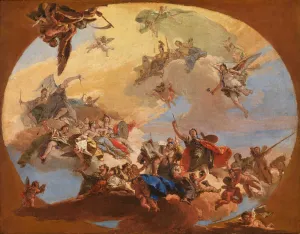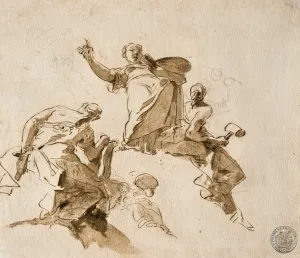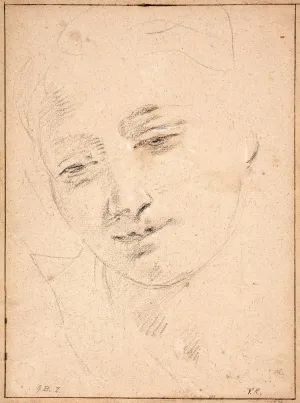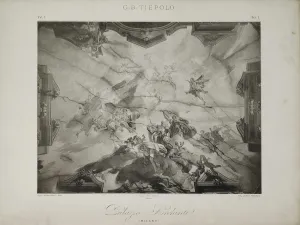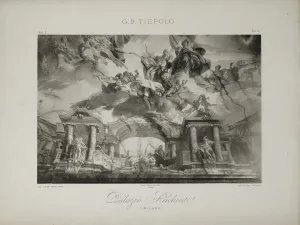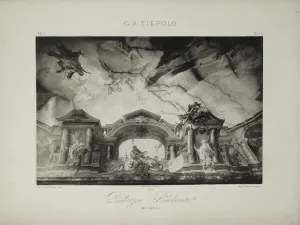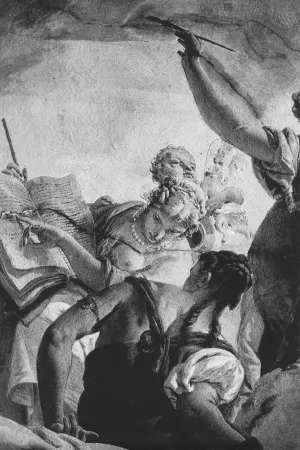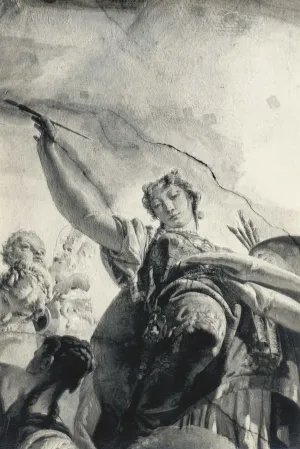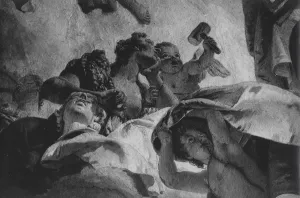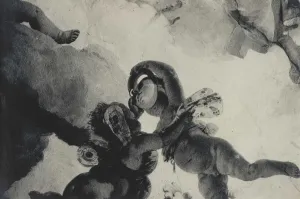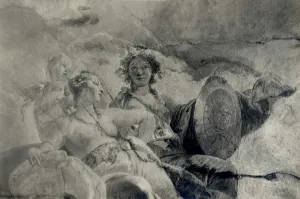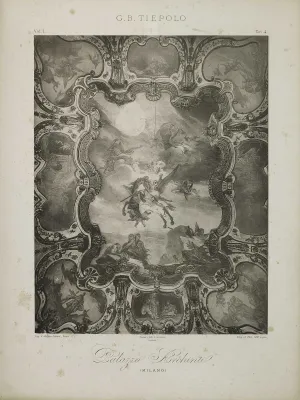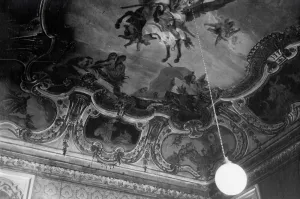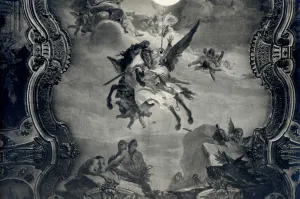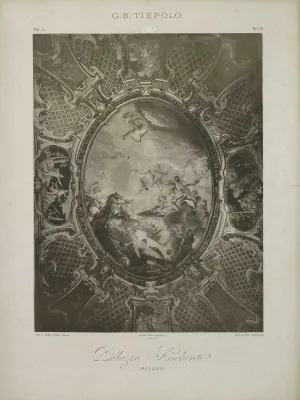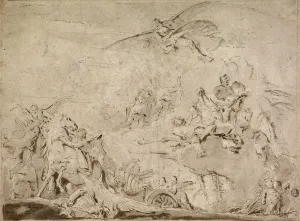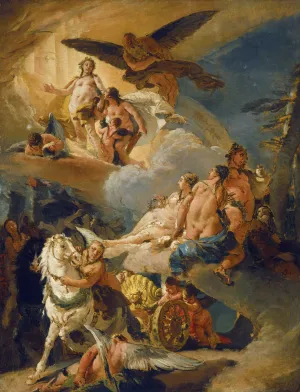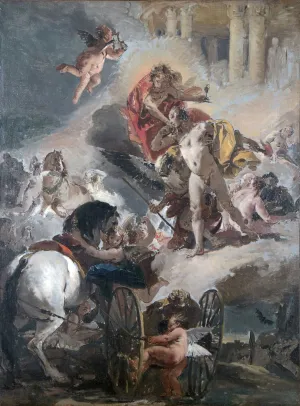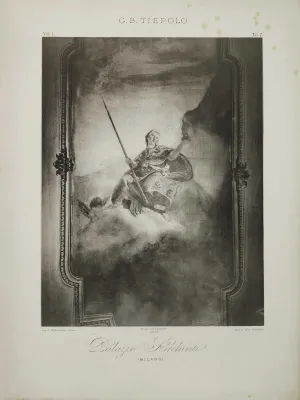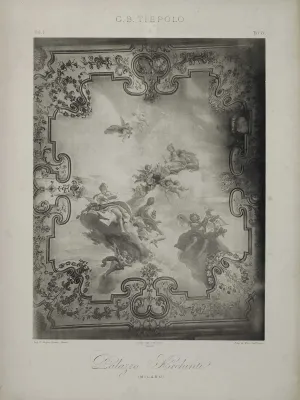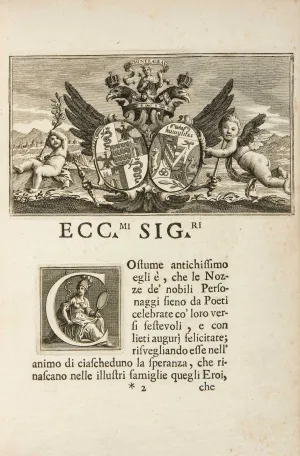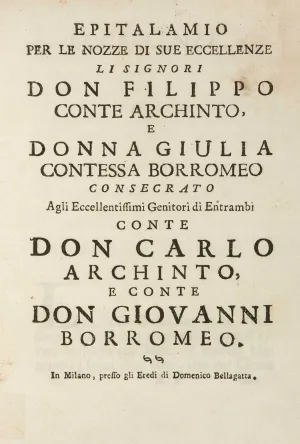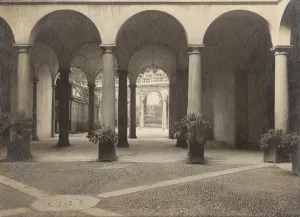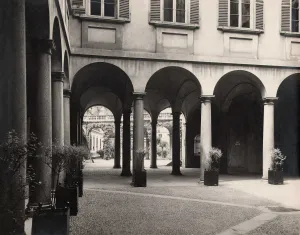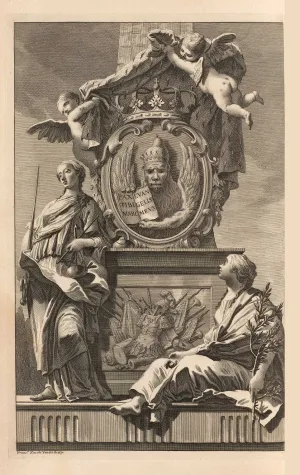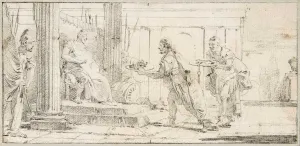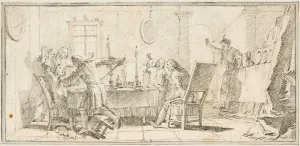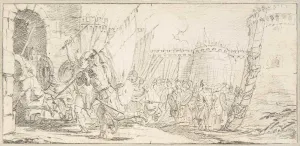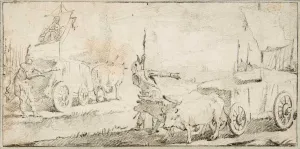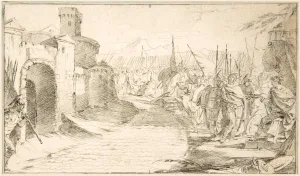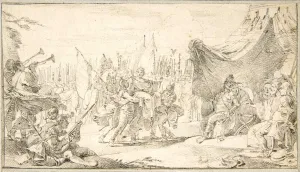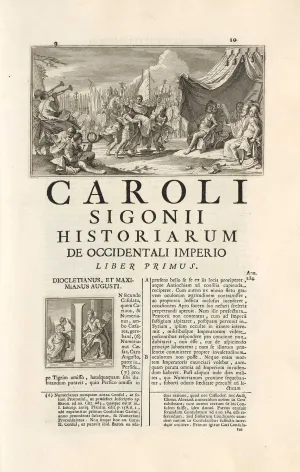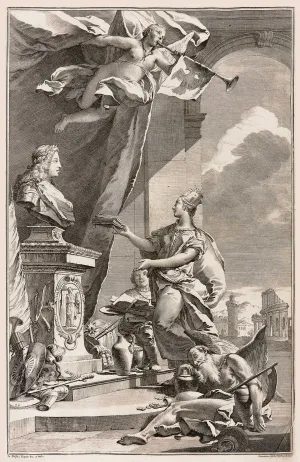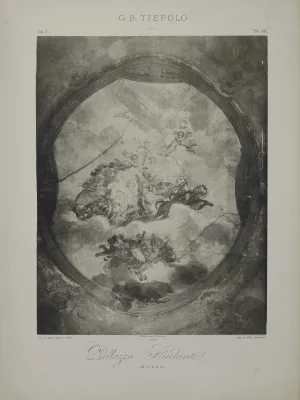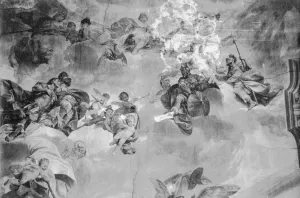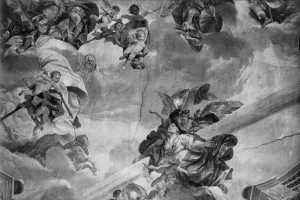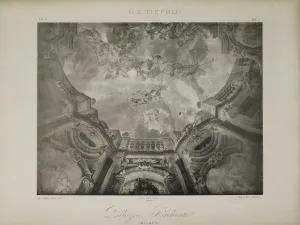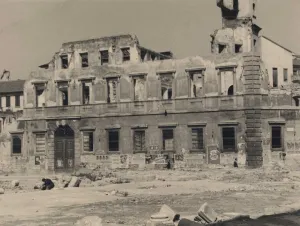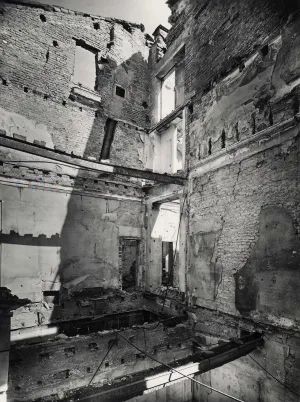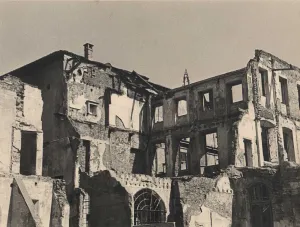Checklist
Giambattista Tiepolo (1696–1770)
Triumph of the Arts and Sciences, ca. 1730–31
Oil on canvas
21 7/8 × 28 3/8 in. (55.5 × 72 cm)
Museu Nacional de Arte Antiga, Lisbon
© Direção-Geral do Património Cultural / Arquivo de Documentação Fotográfica (DGPC/ADF); photo Luisa Oliveira
This is one of three surviving sketches by Tiepolo for Palazzo Archinto, here reunited for the first time. When Tiepolo painted this one, he had no idea what the quadratura around the fresco was going to look like; he therefore left his figures hovering in a cloudy sky, surrounded by an area of brown ocher color. The allegorical figures that populate this sketch are portrayed under the protection of Minerva and Apollo. At top left is Saturn, winged and with his scythe to signify the timeless nature of the arts and sciences.
Giambattista Tiepolo (1696–1770)
Study for Four Female Figures, 1730–31
Pen, brown ink, and black chalk, on white paper
11 3/8 × 13 3/8 in. (288 × 340 mm)
Civico Museo Sartorio, Trieste
For his fresco cycles, Tiepolo executed a number of preparatory drawings that study compositional solutions for his figurative groups. This is the only extant pen sketch for the Archinto cycle. Here Tiepolo studied the central group of figures for the Triumph of the Arts and Sciences, focusing on the allegorical figures of Literature (or History), Painting, and Sculpture.
Giambattista Tiepolo (1696–1770)
Study of Female Head (recto); Study of Foreshortened Head (verso), 1730–31
Black and white chalk on gray-white paper, recto framed in pen and brown ink
11 1/4 × 8 1/4 in. (285 × 210 mm)
Finnish National Gallery, Sinebrychoff Art Museum, Helsinki
Finnish National Gallery / Jenni Nurminen
The study on the recto, likely drawn from a model, was used for the central figure of Painting in the Triumph of the Arts and Sciences. The focus is on the soft shadows created by the light coming from the left and on the simple line of the contour of the figure's oval face. The study on the verso (upside down) is probably for the bust that Tiepolo placed next to the allegory of Sculpture in the final fresco.
Giambattista Tiepolo (1696–1770)
Triumph of the Arts and Sciences, ca. 1730–31 (destroyed 1943)
From Attilio Centelli and Gerardo Molfese, Gli affreschi di G.B. Tiepolo raccolti da Gerardo Molfese con uno studio di Attilio Centelli (Turin, 1897), pl. 1
Page from unbound book
17 5/8 × 23 1/2 in. (448 × 598 mm)
Azienda di Servizi alla Persona Golgi-Redaelli, Milan
su autorizzazione dell'Azienda di Servizi alla Persona Golgi-Redaelli di Milano
As can be seen from the pre-war photographs, there are several differences between the Lisbon sketch and the final fresco. The addition of the quadratura in the final ceiling meant that the figures were repositioned in relation to the fictive architecture. In the final fresco, Saturn is shown seated on the tympanum of a building; the putto seated under Painting was given wooden squares rather than a mask; and the two putti in the sketch at bottom left and right were eliminated.
Giambattista Tiepolo (1696–1770)
Triumph of the Arts and Sciences, ca. 1730–31 (destroyed 1943)
From Attilio Centelli and Gerardo Molfese, Gli affreschi di G.B. Tiepolo raccolti da Gerardo Molfese con uno studio di Attilio Centelli (Turin, 1897), pl. 2
Page from unbound book
17 5/8 × 23 1/2 in. (448 × 598 mm)
Azienda di Servizi alla Persona Golgi-Redaelli, Milan
su autorizzazione dell'Azienda di Servizi alla Persona Golgi-Redaelli di Milano
Giambattista Tiepolo (1696–1770)
Triumph of the Arts and Sciences, ca. 1730–31 (destroyed 1943)
From Attilio Centelli and Gerardo Molfese, Gli affreschi di G.B. Tiepolo raccolti da Gerardo Molfese con uno studio di Attilio Centelli (Turin, 1897), pl. 3
Page from unbound book
17 5/8 × 23 1/2 in. (448 × 598 mm)
Azienda di Servizi alla Persona Golgi-Redaelli, Milan
su autorizzazione dell'Azienda di Servizi alla Persona Golgi-Redaelli di Milano
Giambattista Tiepolo (1696–1770)
Triumph of the Arts and Sciences (detail), ca. 1730–31 (destroyed 1943)
Unknown photographer, 1940
6 3/4 × 4 3/8 in. (172 × 112 mm)
Azienda di Servizi alla Persona Golgi-Redaelli, Milan
su autorizzazione dell'Azienda di Servizi alla Persona Golgi-Redaelli di Milano
Giambattista Tiepolo (1696–1770)
Triumph of the Arts and Sciences (detail), ca. 1730–31 (destroyed 1943)
Unknown photographer, 1940
6 3/4 × 4 3/8 in. (172 × 112 mm)
Azienda di Servizi alla Persona Golgi-Redaelli, Milan
su autorizzazione dell'Azienda di Servizi alla Persona Golgi-Redaelli di Milano
Giambattista Tiepolo (1696–1770)
Triumph of the Arts and Sciences (detail), ca. 1730–31 (destroyed 1943)
Unknown photographer, 1940
4 3/8 × 6 3/4 in. (112 × 172 mm)
Azienda di Servizi alla Persona Golgi-Redaelli, Milan
su autorizzazione dell'Azienda di Servizi alla Persona Golgi-Redaelli di Milano
Giambattista Tiepolo (1696–1770)
Triumph of the Arts and Sciences (detail), ca. 1730–31 (destroyed 1943)
Unknown photographer, 1940
4 3/8 × 6 3/4 in. (112 × 172 mm)
Azienda di Servizi alla Persona Golgi-Redaelli, Milan
su autorizzazione dell'Azienda di Servizi alla Persona Golgi-Redaelli di Milano
Giambattista Tiepolo (1696–1770)
Triumph of the Arts and Sciences (detail), ca. 1730–31 (destroyed 1943)
Unknown photographer, 1940
6 3/4 × 4 3/8 in. (172 × 112 mm)
Azienda di Servizi alla Persona Golgi-Redaelli, Milan
su autorizzazione dell'Azienda di Servizi alla Persona Golgi-Redaelli di Milano
Giambattista Tiepolo (1696–1770)
Triumph of the Arts and Sciences (detail), ca. 1730–31 (destroyed 1943)
Unknown photographer, 1940
4 3/8 × 6 3/4 in. (112 × 172 mm)
Azienda di Servizi alla Persona Golgi-Redaelli, Milan
su autorizzazione dell'Azienda di Servizi alla Persona Golgi-Redaelli di Milano
Giambattista Tiepolo (1696–1770)
Perseus and Andromeda, ca. 1730–31
Oil on canvas
20 3/8 x 16 in. (51.8 x 40.6 cm)
The Frick Collection, New York
© The Frick Collection
Tiepolo took liberties with Ovid's Metamorphoses in showing Perseus riding the winged horse Pegasus instead of flying by way of a pair of winged sandals, as in the original text. At the bottom is the rock on which Andromeda was chained, with remnants of her shackles still attached to it. In the sea below is the dying monster, with Perseus's lance — which has shattered upon piercing its head — above its eye. To the left, and behind the rock, are five Nereids, crying, presumably for the death of the monster, as well as from the humiliation suffered because of Cassiopeia's comments.
Giambattista Tiepolo (1696–1770)
Perseus and Andromeda, ca. 1730-31 (destroyed 1943)
From Attilio Centelli and Gerardo Molfese, Gli affreschi di G.B. Tiepolo raccolti da Gerardo Molfese con uno studio di Attilio Centelli (Turin, 1897), pl. 4
Page from unbound book
23 1/2 × 17 5/8 in. (598 × 448 mm)
Azienda di Servizi alla Persona Golgi-Redaelli, Milan
su autorizzazione dell'Azienda di Servizi alla Persona Golgi-Redaelli di Milano
The overall configuration of the Perseus and Andromeda fresco in Palazzo Archinto was very similar to the one shown in the sketch, which was likely presented to Carlo Archinto for approval. There were, however, some significant changes. The position of the proper right arm of the central Nereid was altered, and two additional figures were added in the final fresco. To the left of Cassiopeia, a crowned male figure was included — Cepheus — and the god Mercury was added below Jupiter.
Giambattista Tiepolo (1696–1770)
Perseus and Andromeda (detail), ca. 1730–31 (destroyed 1943)
Unknown photographer, 1940
4 3/8 × 6 3/4 in. (112 × 172 mm)
Azienda di Servizi alla Persona Golgi-Redaelli, Milan
su autorizzazione dell'Azienda di Servizi alla Persona Golgi-Redaelli di Milano
Giambattista Tiepolo (1696–1770)
Perseus and Andromeda (detail), ca. 1730–31 (destroyed 1943)
Unknown photographer, 1940
4 3/8 × 6 3/4 in. (112 × 172 mm)
Azienda di Servizi alla Persona Golgi-Redaelli, Milan
su autorizzazione dell'Azienda di Servizi alla Persona Golgi-Redaelli di Milano
Giambattista Tiepolo (1696–1770)
Apollo and Phaëton, ca. 1730–31
Oil on canvas
25 1/4 × 18 3/4 in. (64.1 × 47.6 cm)
Los Angeles County Museum of Art
Tiepolo set this scene in the dwelling of the Sun, described by Ovid as decorated with high columns and resplendent in golden light. Two winged figures close the composition at top and bottom. Above is Saturn, the god of Time, swooping down from the sky, holding his scythe. On the ground, fast asleep, is Morpheus, god of slumber, accompanied by another winged, sleeping figure.
Giambattista Tiepolo (1696–1770)
Apollo and Phaëton, ca. 1730-31 (destroyed 1943)
From Attilio Centelli and Gerardo Molfese, Gli affreschi di G.B. Tiepolo raccolti da Gerardo Molfese con uno studio di Attilio Centelli (Turin, 1897), pl. 9
Page from unbound book
23 1/2 × 17 5/8 in. (598 × 448 mm)
Azienda di Servizi alla Persona Golgi-Redaelli, Milan
su autorizzazione dell'Azienda di Servizi alla Persona Golgi-Redaelli di Milano
The compositions of the final Archinto fresco and that of the Los Angeles sketch are almost identical. The positions of Autumn and Winter vary slightly, with the two figures closer together in the fresco. The depiction of sunflowers is also altered, as is the position of Phaëton's proper right arm. He holds the whip at a different angle.
School of Giambattista Tiepolo (1696–1770)
Apollo and Phaëton, ca. 1730–40
Pen and brown ink over a black chalk sketch, brown watercolor and white lead on gray-green paper
15 1/4 × 20 1/2 in. (386 × 521 mm)
The British Museum, London
© Trustees of the British Museum
Traditionally attributed to Tiepolo and linked to his frescoes at Palazzo Archinto, this drawing seems to be an independent work not directly related to the Milanese fresco cycle or the Los Angeles sketch. The quality of the drawing is inferior to that usually achieved by Tiepolo. It may have been executed by Francesco Zugno, who worked alongside Tiepolo on the Rerum Italicarum Scriptores in the early 1730s.
Giambattista Tiepolo (1696–1770)
Apollo and Phaëton, ca. 1730–35
Oil on canvas
26 3/4 × 20 7/8 in. (68 × 53 cm)
Gemäldegalerie der Akademie der bildenden Künst, Vienna
Gemäldegalerie der Akademie der bildenden Künste Wien
This painting depicts the same episode shown in the Archinto ceiling. Here, the principal grouping of Apollo and his son Phaëton appears at the top left. Apollo stands on a cloud, while Phaëton kneels in front of him, holding a torch. Above them, Time flies inexorably. On the right are the Four Seasons, not dissimilar in composition from the Archinto fresco. Below them, the Hours tether two horses to the gold chariot of the Sun. A younger winged figure appears at the top, pouring water out of a vase and extinguishing a torch. This is probably Lucifer, the morning star.
Giambattista Tiepolo (1696–1770)
Apollo and Phaëton, ca. 1735–40
Oil on canvas
38 5/8 × 29 in. (98.1 × 73.6 cm)
The Bowes Museum, Barnard Castle, County Durham, United Kingdom
This painting depicts the same episode that Tiepolo frescoed on one of the five ceilings of Palazzo Archinto. Apollo, draped in red, holds a small vase with the ointment that was to protect his son's face while driving the chariot of the Sun. A Cupid flies into the composition, bringing Apollo his lyre. In the background, to the right, are the Four Seasons. Below, the Hours and a Cupid tie the horses to the gold chariot, though here, with its large wheels, it is closer to a country buggy. In the distant background, to the right, is Morpheus, asleep, with a bat flying overhead.
Giambattista Tiepolo (1696–1770)
Nobility, ca. 1730–31
From Attilio Centelli and Gerardo Molfese, Gli affreschi di G.B. Tiepolo raccolti da Gerardo Molfese con uno studio di Attilio Centelli (Turin, 1897), pl. 7
Page from unbound book
23 1/2 × 17 5/8 in. (598 × 448 mm)
Azienda di Servizi alla Persona Golgi-Redaelli, Milan
su autorizzazione dell'Azienda di Servizi alla Persona Golgi-Redaelli di Milano
Giambattista Tiepolo (1696–1770)
Juno, Venus, and Fortune, ca. 1730–31
From Attilio Centelli and Gerardo Molfese, Gli affreschi di G.B. Tiepolo raccolti da Gerardo Molfese con uno studio di Attilio Centelli (Turin, 1897), pl. 8
Page from unbound book
23 1/2 × 17 5/8 in. (598 × 448 mm)
Azienda di Servizi alla Persona Golgi-Redaelli, Milan
su autorizzazione dell'Azienda di Servizi alla Persona Golgi-Redaelli di Milano
Dedication Page for Filippo Argelati's Le Ode di Anacreonte (Milan, 1731)
Biblioteca Nazionale Braidense, Milan
Su concessione del Ministero dei beni e delle attività culturali e del turismo; photo Mauro Ranzani
This book was produced as a wedding gift to Filippo Archinto and Giulia Borromeo, who married on April 22, 1731. Filippo Argelati, the Archinto family librarian, chose to dedicate to the couple some "amorous compositions": the Odes by Anacreon. The preface of the book opens with the two families' coats of arms (Archinto on the left and Borromeo on the right).
Frontispiece for Antonio Gantelmi's Epitalamio per le nozze di sue eccellenze li signori Don Filippo Archinto e Donna Giulia Contessa Borromeo (Milan, 1731)
Biblioteca Nazionale Braidense, Milan
Su concessione del Ministero dei beni e delle attività culturali e del turismo; photo Mauro Ranzani
Antonio Gantelmi published this short poem as a wedding gift to Filippo Archinto and Giulia Borromeo, who married on April 22, 1731. He dedicated it to Carlo Archinto and Giovanni Borromeo, the fathers of the groom and bride.
Vincenzo Aragozzini (act. early to mid-20th century)
Facade of Palazzo Archinto, 1934
11 3/8 × 9 1/8 in. (289 × 232 mm)
Azienda di Servizi alla Persona Golgi-Redaelli, Milan
su autorizzazione dell'Azienda di Servizi alla Persona Golgi-Redaelli di Milano
For the most part, the exterior of Palazzo Archinto appears today as it did in the seventeenth-century. The somber architecture, with the main portal on Via Olmetto, is typical of the design of seventeenth-century Milanese palazzos.
Unknown photographer
First courtyard of Palazzo Archinto, ca. 1920
5 × 11 5/8 in. (126 × 294 mm)
Azienda di Servizi alla Persona Golgi-Redaelli, Milan
su autorizzazione dell'Azienda di Servizi alla Persona Golgi-Redaelli di Milano
Vincenzo Aragozzini (act. early to mid-20th century)
First courtyard of Palazzo Archinto, 1934
9 1/8 × 11 3/8 in. (232 × 288 mm)
Azienda di Servizi alla Persona Golgi-Redaelli, Milan
su autorizzazione dell'Azienda di Servizi alla Persona Golgi-Redaelli di Milano
Palazzo Archinto has two large consecutive internal courtyards, around which its rooms are arranged. The main staircase, which leads to the piano nobile, is located to the side of this first courtyard.
Vincenzo Aragozzini (act. early to mid-20th century)
View of the courtyards of Palazzo Archinto, 1934
9 1/8 × 11 3/8 in. (231 × 288 mm)
Azienda di Servizi alla Persona Golgi-Redaelli, Milan
su autorizzazione dell'Azienda di Servizi alla Persona Golgi-Redaelli di Milano
The second courtyard leads to the internal garden. A series of courtyards culminating in a garden was a common feature of seventeenth- and eighteenth-century Milanese palazzos. The balcony over the second courtyard's arcade connected the family's rooms to the library.
Francesco Zucchi (1672–1750) after Giambattista Tiepolo (1696–1770)
Allegory of Peace and Justice Paying Homage to the Lion of St. Mark
From Ludovico Antonio Muratori, Rerum Italicarum Scriptores (Milan, 1723–51), frontispiece for vol. 12
Columbia University Libraries, Columbia University in the City of New York
Muratori's Rerum Italicarum Scriptores is a twenty-five volume compilation of Italian historical sources, most of which date to the Middle Ages. Among those from whom the Società Palatina secured financial support for the project was the Republic of Venice, which through the agency of its ambassador in Milan, Giacomo Busenello, sponsored volume 12, on Venetian history. Tiepolo designed the frontispiece, in which allegorical figures of Justice (with a sword and weight scale) and Peace (with a laurel branch) flank the lion of St. Mark, symbol of Venice.
Giambattista Tiepolo (1696–1770)
Presentation of a Decapitated Head and the Keys to the City
Drawn for Ludovico Antonio Muratori, Rerum Italicarum Scriptores,
ca. 1725–30
Black chalk reworked with traces of red chalk on white paper
3 × 6 1/8 in. (75 × 155 mm)
The Metropolitan Museum of Art, New York
© The Metropolitan Museum of Art / Art Resource, NY
Giambattista Tiepolo (1696–1770)
The Italian Flagellant Movement
Drawn for Ludovico Antonio Muratori, Rerum Italicarum Scriptores, ca. 1725–30
Black chalk on white paper
3 1/8 × 6 1/2 in. (80 × 166 mm)
The Metropolitan Museum of Art, New York
© The Metropolitan Museum of Art / Art Resource, NY
Giambattista Tiepolo (1696–1770)
The Assassination of Count Ghiazolo in Rimini in 1326
Drawn for Ludovico Antonio Muratori, Rerum Italicarum Scriptores,
ca. 1725–30
Black chalk on white paper
2 7/8 × 6 1/8 in. (74 × 157 mm)
The Metropolitan Museum of Art, New York
© The Metropolitan Museum of Art / Art Resource, NY
Giambattista Tiepolo (1696–1770)
The Coronation of Henry VII in Milan in 1311
Drawn for Ludovico Antonio Muratori, Rerum Italicarum Scriptores,
ca. 1725–30
Black chalk on white paper
3 × 6 1/8 in. (77 × 156 mm)
The Metropolitan Museum of Art, New York
© The Metropolitan Museum of Art / Art Resource, NY
Francesco Zucchi (1672–1750) after Giambattista Tiepolo (1696–1770)
The Coronation of Henry VII in Milan in 1311
From Ludovico Antonio Muratori, Rerum Italicarum Scriptores (Milan, 1723–51), vol. 16
Columbia University Libraries, Columbia University in the City of New York
Columbia University Libraries, Columbia University in the City of New York
Tiepolo provided delicate designs for a number of engravings by Francesco Zucchi for many of the volumes of Muratori's Rerum Italicarum Scriptores. One of the headpieces of volume 16 relates to the text it introduces: an anonymous account of the history of Milan. Tiepolo depicted the coronation of Emperor Henry VII as King of Italy, which took place in Milan on January 6, 1311. The original drawing for this print is also shown in the exhibition.
Giambattista Tiepolo (1696–1770)
Siege of a City
Drawn for Carlo Sigonio, Opera Omnia, 1730–31
Black chalk on white paper
2 7/8 × 6 in. (73 × 151 mm)
The Metropolitan Museum of Art, New York
© The Metropolitan Museum of Art / Art Resource, NY
Giambattista Tiepolo (1696–1770)
The Exchange of Ox Carts between Parma and Cremona in 1281
Drawn for Ludovico Antonio Muratori, Rerum Italicarum Scriptores,
ca. 1725–30
Black chalk on white paper
3 × 6 in. (76 × 154 mm)
The Metropolitan Museum of Art, New York
© The Metropolitan Museum of Art / Art Resource, NY
Francesco Zucchi (1672–1750) after Francesco Zugno (1709–1787)
Alberico Archinto and an Allegory of the Catholic Faith
From Carlo Sigonio, Opera Omnia (Milan, 1732–37), headpiece for vol. 5
Columbia University Libraries, Columbia University in the City of New York
Carlo's son, Alberico Archinto, pursued an ecclesiastical career and was among the scholars who annotated parts of the Rerum Italicarum Scriptores and supported the Società Palatina. The fifth volume of Sigonio's Opera Omnia was dedicated to Alberico, whose portrait, accompanied by an allegory of the Catholic Faith, appears on the headpiece. This was designed by Tiepolo's pupil and collaborator, Francesco Zugno, whose original drawings for this print are at the Metropolitan Museum of Art, New York, and the Castello Sforzesco, Milan.
Giambattista Tiepolo (1696–1770)
Siege of a City
Drawn for Ludovico Antonio Muratori, Rerum Italicarum Scriptores,
ca. 1725–30
Black chalk on white paper
4 3/8 × 7 1/2 in. (112 × 192 mm)
The Metropolitan Museum of Art, New York
© The Metropolitan Museum of Art / Art Resource, NY
The preparatory drawings Tiepolo made to accompany the medieval texts collected by Muratori in Rerum Italicarum Scriptores represent scenes from Italian history. Many of the events depicted cannot be precisely identified, however, and on more than one occasion, the drawings are used multiple times, to illustrate different events.
Giambattista Tiepolo (1696–1770)
Triumph of a Roman Emperor
Drawn for Carlo Sigonio, Opera Omnia, 1730–31
Black chalk reworked with traces of red chalk on white paper
4 3/8 × 7 1/2 in. (110 × 191 mm)
The Metropolitan Museum of Art, New York
© The Metropolitan Museum of Art / Art Resource, NY
Francesco Zucchi (1672–1750) after Giambattista Tiepolo (1696–1770)
Triumph of a Roman Emperor
From Carlo Sigonio, Opera Omnia (Milan, 1732–37), headpiece for vol. 1
Columbia University Libraries, Columbia University in the City of New York
One of the publications produced by the Società Palatina was the six-volume Opera Omnia, the collected works of the sixteenth-century historian Carlo Sigonio. The headpiece for the first volume — representing the triumph of an ancient Roman emperor as he is carried by his generals to a tent — is based on a drawing by Tiepolo.
Francesco Zucchi (1672–1750) after Giambattista Tiepolo (1696–1770)
Italy Presenting the Volume to Charles VI
From Francesco Mediobarbo Birago, Imperatorum Romanorum Numismata (Milan, 1730), frontispiece
Mount Holyoke College Archives and Special Collections, South Hadley
The Imperatorum Romanorum Numismata, dedicated to Emperor Charles VI in Vienna, was the last of the Società Palatina volumes with which Tiepolo was involved. Its subject is the study made by Francesco Mediobarbo, Count of Birago, of two hundred thirty-five ancient Roman coins, dating from the age of Pompey to the age of Emperor Heraclius. The frontispiece features the personification of Italy presenting the book to the emperor, shown in the form of a bust against a background of ancient ruins.
Vittorio Maria Bigari (1692–1776)
Bacchus and Ariadne, ca. 1730–31 (destroyed 1943)
From Attilio Centelli and Gerardo Molfese, Gli affreschi di G.B. Tiepolo raccolti da Gerardo Molfese con uno studio di Attilio Centelli (Turin, 1897), pl. 10
Page of unbound book
23 1/2 × 17 5/8 in. (598 × 448 mm)
Azienda di Servizi alla Persona Golgi-Redaelli, Milan
su autorizzazione dell'Azienda di Servizi alla Persona Golgi-Redaelli di Milano
This triumphal scene of Bacchus and Ariadne in a chariot drawn by panthers celebrates the encounter between the god of wine and the beautiful Ariadne, who had been abandoned on the island of Naxos by Theseus. The fresco likely referred to the wedding, in 1731, of Filippo Archinto and Giulia Borromeo.
Vittorio Maria Bigari (1692–1776)
Truth Unveiled by Time, ca. 1730–31
Unknown photographer, 1940
6 3/4 × 4 3/8 in. (172 × 112 mm)
Azienda di Servizi alla Persona Golgi-Redaelli, Milan
su autorizzazione dell'Azienda di Servizi alla Persona Golgi-Redaelli di Milano
Depicting Truth unveiled by Time on clouds in the sky, Bigari's fresco for the ceiling of a small room is the only intact painting that survived the 1943 bombing of the palazzo. The fresco was detached from the ruins of the palazzo in 1960–66 and is still preserved there.
Vittorio Maria Bigari (1692–1776)
Apotheosis of Romulus (detail), ca. 1730–31 (destroyed 1943)
Unknown photographer, 1940
4 3/8 × 6 3/4 in. (112 × 172 mm)
Azienda di Servizi alla Persona Golgi-Redaelli, Milan
su autorizzazione dell'Azienda di Servizi alla Persona Golgi-Redaelli di Milano
This photograph taken before the 1943 bombing shows a detail of Bigari's Apotheosis of Romulus. Bigari depicted the mythical founder of Rome being presented to Jupiter by Mars. Around them are the gods who favored Rome, as well as those who opposed it.
Vittorio Maria Bigari (1692–1776)
Apotheosis of Romulus (detail), ca. 1730–31 (destroyed 1943)
Unknown photographer
4 3/8 × 6 3/4 in. (112 × 172 cm)
Azienda di Servizi alla Persona Golgi-Redaelli, Milan
su autorizzazione dell'Azienda di Servizi alla Persona Golgi-Redaelli di Milano
This photograph taken before the 1943 bombing shows a detail of Bigari's Apotheosis of Romulus. Romulus's wife, Hersilia, is brought to Olympus on a rainbow by Iris, through the intercession of Juno.
Vittorio Maria Bigari (1692–1776)
Apotheosis of Romulus, ca. 1730–31 (destroyed 1943)
From Attilio Centelli and Gerardo Molfese, Gli affreschi di G.B. Tiepolo raccolti da Gerardo Molfese con uno studio di Attilio Centelli (Turin, 1897), pl. 5
Page from unbound book
17 5/8 × 23 1/2 in. (448 × 598 cm)
Azienda di Servizi alla Persona Golgi-Redaelli, Milan
su autorizzazione dell'Azienda di Servizi alla Persona Golgi-Redaelli di Milano
A large volume dedicated to the Archinto frescoes was compiled by Attilio Centelli and Gerardo Molfese and published in 1897. Included is a brief text on Tiepolo by Centelli and a series of fifty black-and-white illustrations. The Centelli and Molfese volume attributes all the Archinto frescoes to Tiepolo, but we now know that the Bolognese painter Vittorio Maria Bigari (1692–1776) painted three of them. The Apotheosis of Romulus, Bigari's largest fresco in the palazzo, decorated one of the rooms on the piano nobile.
Vittorio Maria Bigari (1692–1776)
Apotheosis of Romulus, ca. 1730–31 (destroyed 1943)
From Attilio Centelli and Gerardo Molfese, Gli affreschi di G.B. Tiepolo raccolti da Gerardo Molfese con uno studio di Attilio Centelli (Turin, 1897), pl.6
Page from unbound book
17 5/8 × 23 1/2 in. (448 × 598 mm)
Azienda di Servizi alla Persona Golgi-Redaelli, Milan
su autorizzazione dell'Azienda di Servizi alla Persona Golgi-Redaelli di Milano
A large volume dedicated to the Archinto frescoes was compiled by Attilio Centelli and Gerardo Molfese and published in 1897. Included is a brief text on Tiepolo by Centelli and a series of fifty black-and-white illustrations. The Centelli and Molfese volume attributes all the Archinto frescoes to Tiepolo, but we now know that the Bolognese painter Vittorio Maria Bigari (1692–1776) painted three of them. The Apotheosis of Romulus, Bigari's largest fresco in the palazzo, decorated one of the rooms on the piano nobile.
Unknown photographer
Palazzo Archinto after bombing in August 1943, 1948
6 7/8 × 9 1/4 in. (175 × 235 mm)
Azienda di Servizi alla Persona Golgi-Redaelli, Milan
su autorizzazione dell'Azienda di Servizi alla Persona Golgi-Redaelli di Milano
After the bombing in August 1943, Palazzo Archinto remained abandoned and in ruins for a number of years. It was rebuilt between 1955 and 1967. Though the interiors of the palazzo were devastated by the bombing, photographs taken in the 1940s show that the overall architectural structure remained intact.
Unknown photographer
Palazzo Archinto after bombing in August 1943, 1948
9 1/4 × 6 7/8 in. (235 × 174 mm)
Azienda di Servizi alla Persona Golgi-Redaelli, Milan
su autorizzazione dell'Azienda di Servizi alla Persona Golgi-Redaelli di Milano
Antonio Paoletti (1881–1946)
Palazzo Archinto after bombing in August 1943; interior spaces, 1945
9 1/4 × 6 7/8 in. (235 × 175 mm)
Azienda di Servizi alla Persona Golgi-Redaelli, Milan
su autorizzazione dell'Azienda di Servizi alla Persona Golgi-Redaelli di Milano
Antonio Paoletti (1881–1946)
Palazzo Archinto after bombing in August 1943; interior spaces, 1945
9 1/4 × 6 7/8 in. (235 × 175 mm)
Azienda di Servizi alla Persona Golgi-Redaelli, Milan
su autorizzazione dell'Azienda di Servizi alla Persona Golgi-Redaelli di Milano
Unknown photographer
Palazzo Archinto after bombing in August 1943, 1948
6 3/4 × 9 1/4 in. (173 × 235 mm)
Azienda di Servizi alla Persona Golgi-Redaelli, Milan
su autorizzazione dell'Azienda di Servizi alla Persona Golgi-Redaelli di Milano

